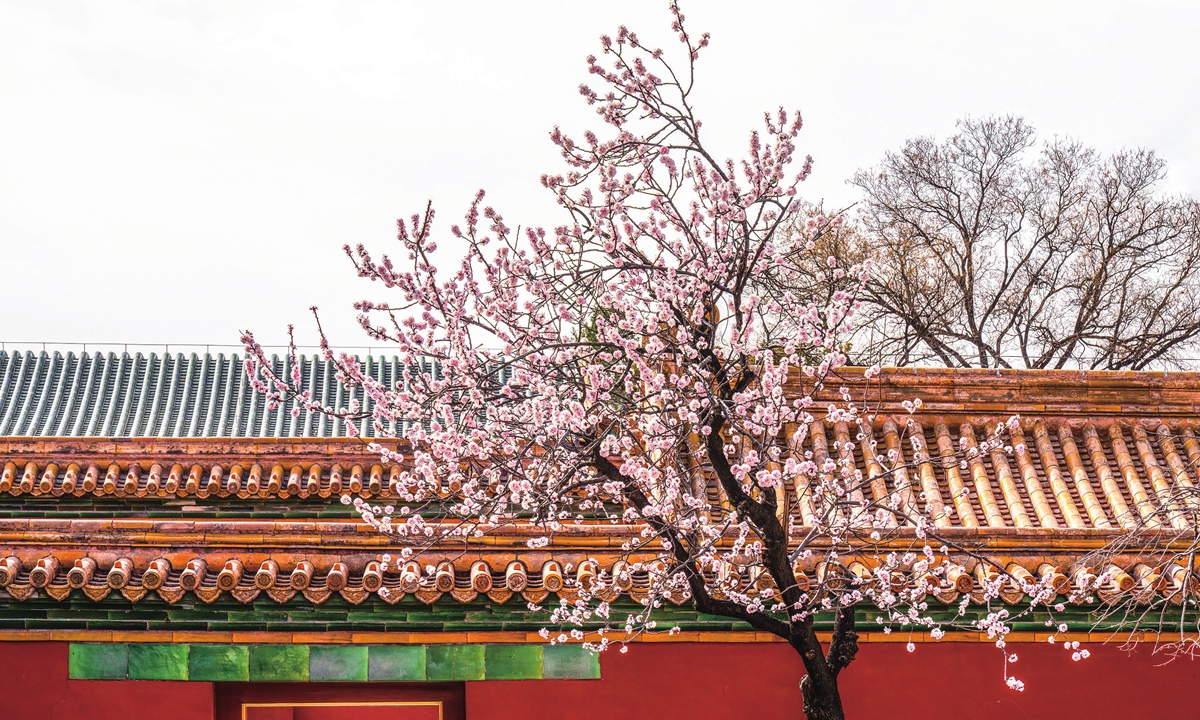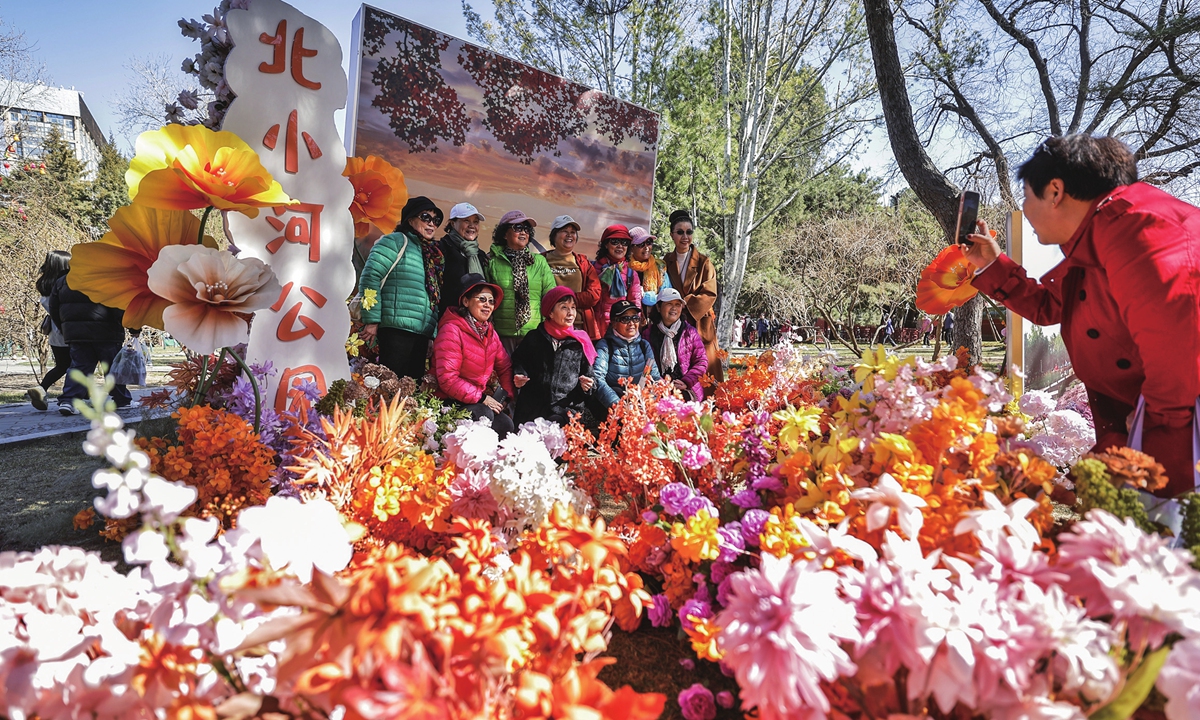
The Palace Museum Photo: VCG

Residents take a group photo at the Chaoyang Garden Festival in Beijing on March 20, 2024. Photo: VCG
With the spring breeze gently reaching every corner of Beijing, a multitude of flowers have come into full bloom, attracting many people to share their floral discoveries on the social media. Posts like "enjoying flowers in Beijing during spring" have become trending topics across different Chinese social media platforms.
The lily tree outside the Forbidden City, with their pink and white blossoms against the red walls, embody the essence of spring. On the campus of Peking University, clusters of winter sweet flowers are blooming, exuding a mild fragrance.
The peach blossoms at the Summer Palace, Chinese crabapple at the former residence of Madame Soong Ching Ling, and peony at Jingshan Park are in full bloom. These and many other options make it hard to decide where to go first to enjoy the capital's seasonal flora.
Here's a flower viewing guide from the Global Times for readers to enjoy Beijing's natural beauty and learn about the stories behind these floral sites.
Magnolia and ancient templesMagnolia is kind of large, white, and fragrant flowers. Native to the mountains of central China, it is now commonly cultivated in gardens around the world.
It has been cultivated in Chinese Buddhist temple gardens since 600. Magnolia was regarded as a symbol of purity in the Tang Dynasty (618-907) and planted at the imperial garden.
Dajue Temple in western Beijing is popular not only for its history and ancient structure, but also for its springtime magnolia blossoms. In the southern courtyard of the temple's Siyi Hall stands an ancient magnolia tree from the Emperor Qianlong's reign in the Qing Dynasty (1644-1911).
It is considered the finest ancient magnolia in Beijing and one of the temple's wonders.
In early spring, the temple's white magnolia trees come into bloom, adding a touch of ancient elegance to the mountain temple.
Due to its location at a high altitude, the temple's magnolia flowers generally bloom about ten days later than that in the city, usually in early April, lasting about a week.
Under sunny and breezy weather conditions, the blooming period may extend for several days.
Situated in the Mentougou district of Beijing, Tanzhe Temple stands as a highly prioritized national cultural heritage site within the capital, located approximately 30 kilometers from downtown Beijing.
Established in the Western Jin Dynasty (265-316), the temple's rich history spans nearly 1,700 years.
There's a well-known saying that encapsulates its significance: "Tanzhe Temple exists before the city of Beijing."
Tanzhe Temple is also home to many ancient and sacred trees related to Buddhism, such as the ancient ginkgo tree, and the ancient sal tree.
In front of the Pilu Pavilion, on the east side stand two Qing Dynasty purple magnolia trees. Despite being over 400 years old, these two trees still show their vibrant color, emitting a captivating fragrance.
While white magnolia is common in Beijing, the purple one is rare.
Such ancient magnolia trees can only be seen in Tanzhe Temple, making them a unique feature of the temple.
Peony at Jingshan Park Peony is a hybrid species originating in China.
It frequently appears in Chinese cultural artifacts, such as women's headgear during the Tang Dynasty (618-907) and Qing Dynasty, detailed brush paintings, and in Hanfu patterns.
In China, peony has always been esteemed as the "king of flowers," akin to the rose in the west. Zhou Dunyi, an outstanding literati and philosopher of the Song Dynasty (960-1276), wrote in his prose "Ai Lian Shuo" (literal translation: Ode to the Lotus Flower), noted, "Since the Tang dynasty, people have greatly adored the peony."
During the Qing Dynasty, peony was designated as China's national flower.
Jingshan Park is one of the most frequented areas for peony viewing in northern China.
The park served as the imperial garden during the Yuan (1279-1368), Ming (1368-1644), and Qing dynasties. Located on the central axis of Beijing during the Ming and Qing dynasties, the park's central hill, Jingshan, was once the highest point of the city.
Throughout the Yuan, Ming, and Qing dynasties, Jingshan and its affiliated buildings were not only a royal garden for leisure but also served multiple functions including archery practice, temporary mortuary for the deceased royals, ancestor worship, official education, opera performances, and religion.
The park has a long history of peony cultivation. It holds an annual event called the "Peony Cultural Season," during which the peony blossoms are put on display for visitors, while experts inform them about peony cultivation techniques, thus allowing the public to gain a deeper understanding of the connection between peony and Jingshan Park.
Crabapple blooms and old mansion The crabapple blossom belongs to the apple genus of the Rosaceae family and is a plant endemic to China. The most popular places for viewing crabapple flowers in Beijing include the Yuan Dynasty Capital City Wall Relics Park, the former residence of Madame Song Qing Ling, Taoranting Park, Zhongshan Park, and Beijing Botanical Garden.
The Yuan Dynasty Capital City Wall Relics Park houses the largest group of crabapple trees in the urban area. Located outside the Deshengmen Gate in the north of the city, the park is planted with a variety of crabapple trees.
The former residence of Madame Soong Ching Ling, a mansion owned by several royal related members, boasts two ancient crabapple trees, which are second-class ancient trees with a circumference of 250 centimeters, a height of 6 meters, and a crown spread of 9 meters.